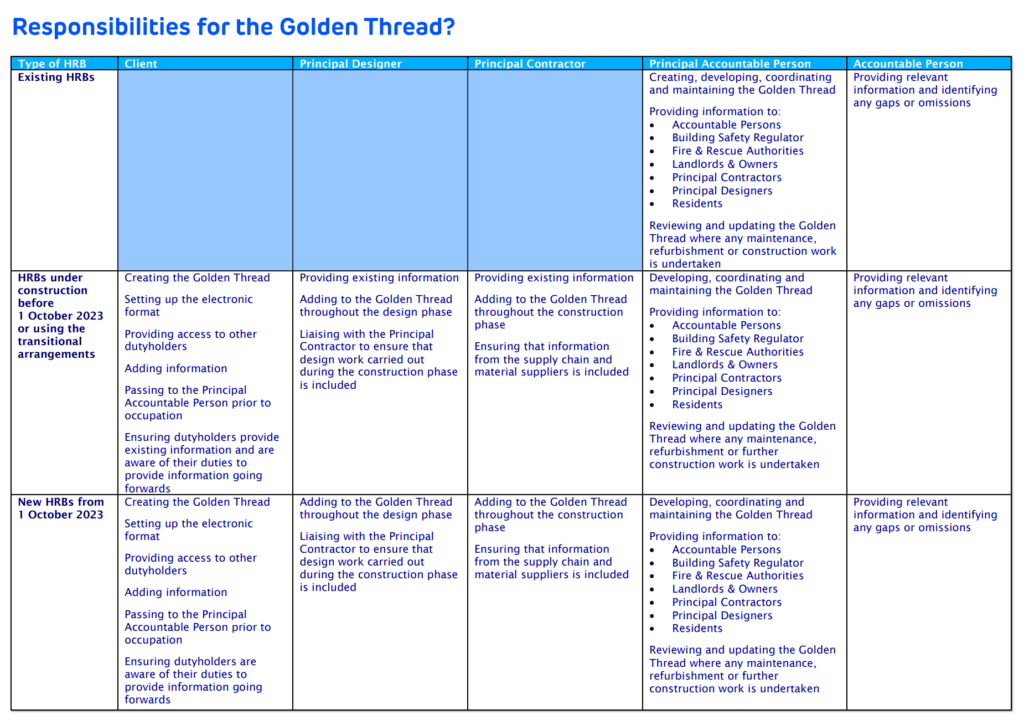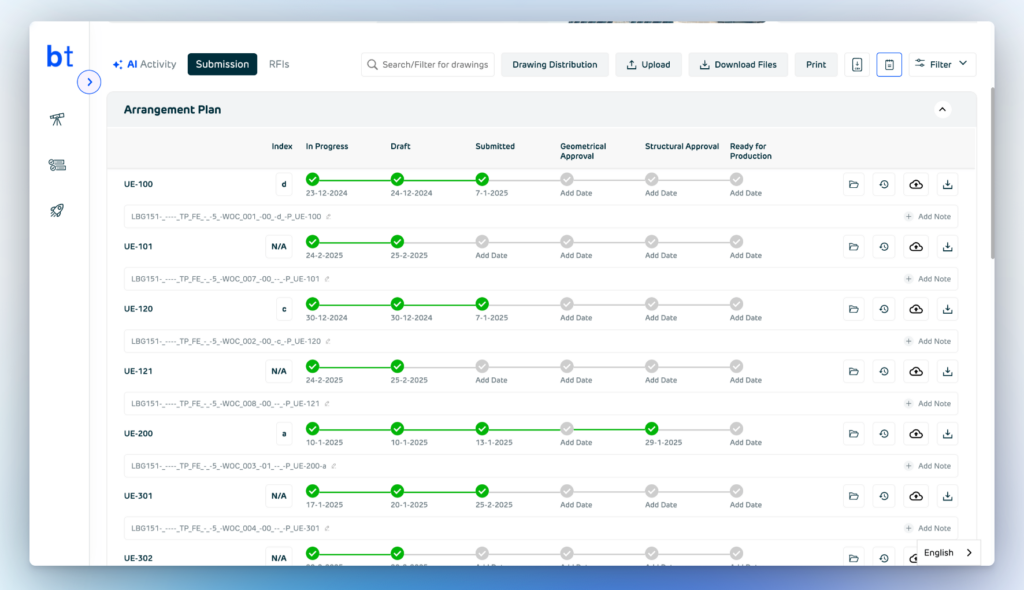Introduction
In recent years, the construction industry has witnessed a paradigm shift in how building safety is managed, driven by the UK government’s push for stricter regulations. The concept of the golden thread stands out as a pioneering approach to building safety. This transformative concept, mandated by the Building Safety Act 2022, emerged in the wake of tragic events like the Grenfell Tower fire and aims to bridge long-standing gaps in building safety management. By creating a single, digital “source of truth,” the Golden Thread ensures that every detail—from design blueprints to maintenance logs—is accessible and accurate throughout a building’s lifecycle. In this article, we explore every facet of the Golden Thread, its requirements, stakeholder roles, real-world examples, and what lies ahead for the construction industry.
Definition and Purpose of the Golden Thread
The golden thread is the comprehensive digital record that every higher risk building must maintain. According to Build UK’s guidance, the golden thread of information is not merely a static document—it is a living digital record that evolves over the building’s life cycle. It stores building information such as design data, maintenance records, and fire safety system specifications.
The purpose of this golden thread is threefold:
- Safety and Accountability: It enables building safety managers and responsible persons to manage building safety risks effectively and mitigate safety risks such as fire spread and structural collapse.
- Transparency: By providing a single source of truth, the golden thread must be accessible to all duty holders, including principal contractors and principal designers, ensuring that both the building and its occupants are protected.
- Regulatory Compliance: The UK government requires that the golden thread information complies with applicable building regulations and legal duties set forth by the building safety act.
When the Golden Thread is Required
The golden thread must be integrated into higher risk buildings at different stages:
- Existing Higher Risk Buildings: For existing structures, the golden thread must be compiled from legacy records including fire safety documents, O&M manuals, and the health and safety file required by the construction industry. Regular reviews ensure the golden thread remains current with building information.
- Buildings Under Construction (Pre-October 2023 or Transitional Arrangements): In these cases, the golden thread must be initiated as soon as possible from available data and updated continuously throughout the design and construction phase.
- New Higher Risk Buildings (From 1 October 2023 Onwards): The golden thread must be in place before any building work commences, ensuring that during the design and construction phase, all data is captured from the very start. A completion certificate cannot be issued without this digital record.
For instance, a recent project involving high rise residential buildings in London integrated a robust golden thread start protocol, ensuring that every document—from the initial building control approval to the final completion certificate application—was digitized and accessible.
Source: GOV UK
Roles and Responsibilities in the Golden Thread Process
The effective management of the golden thread requires clear responsibilities from all parties:
- Client: The client is primarily responsible for creating the golden thread. They must use digital tools to set up the version control system and ensure that the golden thread information is maintained.
- Principal Designers and Principal Contractors: During the design and construction phase, these construction professionals must contribute accurate building information and update the golden threads as necessary.
- Accountable Persons and Building Safety Managers: Once the building is completed, the principal accountable person (the responsible person) takes over the maintenance of the golden thread. These accountable persons, along with building safety managers, must ensure that the golden thread remains up to date to manage building safety risks and mitigate safety risks effectively.

Source: Build UK – November 2024
Format and Content Requirements for the Golden Thread
The golden thread must be structured to facilitate ease of use and data integrity. According to the building safety act and related regulations, it must be:
- Digital Only: All records must be maintained electronically to ensure easy transfer and accessibility without data loss.
- Interoperability: The system should integrate seamlessly with Building Information Modelling (BIM) platforms, ensuring that all stakeholders can access and update data in real time.
- Accurate and Up to Date:
Through strict version control and a change control process, every update is documented. - Security Standards: Compliance with cybersecurity measures such as ISO 27001 is essential, along with GDPR adherence for data privacy.
- Accessibility: The user interface should follow WCAG guidelines to ensure accessibility for all, including people with disabilities.
List: Golden Thread Format Requirements
- Building registration information
- Name and address
- Number of residential units
- Height of the building
- Number of storeys above ground level
- Date of completion
- Building Control Approval information
- Drawings and plans
- Competence declaration
- Construction control plan
- Change control plan and log
- Building Regulations compliance statement
- Fire compliance statement
- Fire and emergency file
- Client authorization
- Site location plan including any new drains and sewers
- Drainage precautions
- Arrangements for staged work
- Partial completion strategy where appropriate
- Certificates and reports
- Planning statement
- Completion certificate
- Building Assessment Certificate
- Safety Case Report
- Inspection and test reports, including recommendations and actions taken
- Maintenance records and actions taken
- Mandatory Occurrence Reports
- Complaints received and actions taken (within the last seven years)
- Any enforcement action
- Inspection regimes
- Statutory inspections required
- Standards to be met
- Maintenance information
- Schedule of planned maintenance for building elements and equipment
- Dealing with faults
- Troubleshooting
- Repair and replacement details
- Competence requirements for maintenance personnel
- Building safety management documentation
- Evacuation strategy
- Mandatory Occurrence Reporting system
- As built drawings
- Up to date site location plan including all services
- Photographic records of building elements and installations during the construction
- process
- Up to date floor plans
- Safety critical Information
- Design principles
- Structural elements
- Utilities
- Compartmentation
- Fire safety systems (i.e. alarm systems, evacuation strategy and escape routes, fire
- doors, firefighting equipment, smoke vents)
- Electrical systems
- Ventilation systems
- Window security systems
- Product specific details
- Certification
- Supplier
- Material content
- Refurbishment specific details
- Hidden services e.g. smoke vents
- Passive fire protection e.g. location of fire collars
- Demolition specific details
- Loadbearing elements
- Post tensioned elements
- Foundation details
Source: Build UK
Implementation Strategies and Best Practices
To effectively implement the golden thread building safety act, construction professionals must follow a structured approach:
- Digital Readiness Assessment:
Assess existing systems to determine if they can store building information securely and support version control. This step ensures that the digital record is robust enough to store building safety information and protect personal information. - Defining Roles and Establishing Protocols:
Clearly assign responsibilities among duty holders. The UK government’s guidelines require that the golden thread must be maintained by all accountable persons and principal contractors, ensuring that each phase—from the design phase through the construction phase—is documented. - Selecting Appropriate Digital Tools:
Utilize digital tools that are compatible with information modelling. For example, many companies in the construction industry have successfully integrated BIM into their golden thread process to create a single source of truth. For example, digital platforms like BuildTwin offer integrated ERP solutions that help manage workflows seamlessly while maintaining compliance with building safety regulations. Get Started>> - Regular Audits and Change Control:
Establish a routine for regular audits of the golden threads to ensure accuracy. A robust change control process is essential to update building information continuously, thereby mitigating building safety risks and ensuring that the golden thread must reflect both the building’s information and any modifications. - Training and Culture Change:
Invest in training for construction professionals and building safety managers. Such training should focus on the principles of the golden thread concept and the importance of maintaining accurate maintenance records. A culture change is required to ensure that all duty holders embrace the digital record system as an integral part of managing building safety.

Digital Tools, BIM & Data Management in the Golden Thread
The successful deployment of the golden thread relies heavily on modern digital tools. These tools help store building safety information and ensure that all data is updated in real time.
Building Information Modelling (BIM):
BIM serves as a dynamic platform where all building information can be visualized and updated in real time, making it easier for building safety regulators and accountable persons to monitor compliance. Key Benefits of BIM Integration:
- Enhanced Collaboration: BIM allows all stakeholders—from construction professionals to building safety managers—to work on a shared digital platform.
- Improved Accuracy: With BIM, the golden thread captures a high level of detail about the design and construction process, reducing the chance of errors.
- Real-Time Updates: The digital record can be updated continuously throughout the construction phase and into occupancy.
A recent study published by the Building Regulations Advisory Committee demonstrated that projects using BIM saw a 25% reduction in delays related to information mismatches.
Common Data Environments (CDE):
A CDE is the digital hub where all golden threads are stored. It provides secure, real-time access to a digital record that complies with stricter regulations. The CDE ensures data consistency even when using different software solutions. Platforms like BuildTwin demonstrate how effective use of CDEs can streamline project management without disrupting existing workflows while supporting the golden thread’s requirements. See in action!
Cloud-Based Platforms:
The move to cloud storage ensures that golden thread data is not only secure but also accessible from anywhere. This allows accountable persons and building safety managers to access critical building information on the go.
Integration with Mobile Devices:
Mobile applications enable real-time updates during the construction process. For example, a principal contractor might use a mobile app to instantly log changes in the field, ensuring that the golden thread is continually accurate.
Security Protocols:
Compliance with standards such as ISO 27001 is essential. These sufficient protocols ensure that the data is protected from cyber threats while remaining accessible to those who need it.
Conclusion
The golden thread is a vital digital record mandated by the building safety act, ensuring that all critical building information is accurate and accessible throughout a building’s lifecycle. Clear accountability—assigned to accountable persons, principal designers, and principal contractors—helps manage safety risks and maintain compliance.
Real-world projects in London and Birmingham show that effective implementation of the golden thread not only boosts safety but also builds public trust. Ultimately, integrating digital tools and BIM is a practical step toward improved building safety and operational efficiency.
For those ready to elevate their project management approach and ensure every building detail is captured seamlessly, consider exploring innovative digital solutions that support the golden thread process. Schedule a call >>



